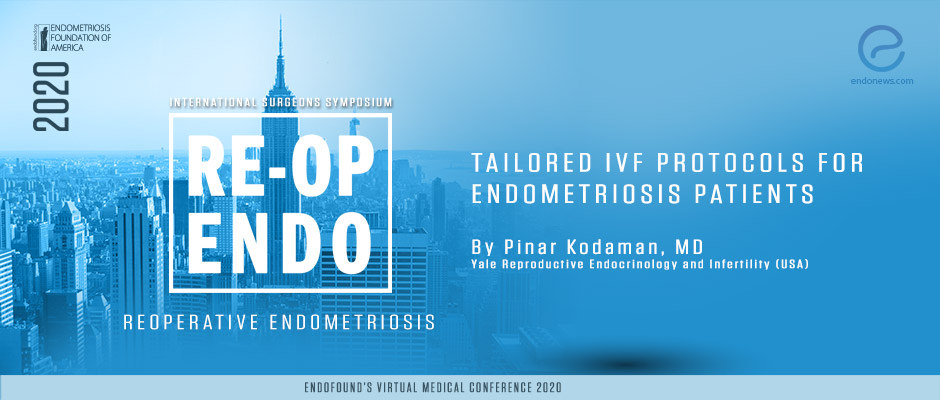In vitro fertilization protocols in endometriosis patients - Pinar Kodaman, MD., PhD.
Dec 8, 2020
Endometriosis is associated with infertility due to several factors including pelvic adhesions, decreased tubal function and sperm motility, and alterations in endometrial receptivity.
Key Points
Information for the presentation: This presentation by Dr. Pinar Kodaman, MD., PhD., a reproductive endocrinologist, infertility specialist, and the director of the Advanced Endoscopic Reproductive Surgery Program at the Yale Fertility Center, is about different in vitro fertilization protocols that can be recommended for patients having endometriosis-related infertility. Her presentation at the 2020 Endofound Medical Conference is about "Tailored in vitro fertilization protocols in infertility patients."
Highlights:
- In vitro fertilization is the most preferred and effective therapy for endometriosis-related infertility.
Importance:
- The optimal controlled ovarian stimulation should be determined based on age, ovarian reserve, and disease stage in endometriosis patients.
Remarks:
- This talk by Dr. Pinar Kodaman is about different in vitro fertilization protocols that can be recommended for patients having endometriosis-related infertility.
- The flow chart includes the relationship between endometriosis and infertility, underlying mechanisms, the most optimal ovarian stimulation along with trigger modalities, and embryo transfer timing based on evidence.
- Infertility can be encountered in up to 50% of women with endometriosis, and up to 50% of women with infertility can be diagnosed with endometriosis.
- It is not possible to predict which women are at higher risk for infertility in endometriosis.
- The most preferred and effective treatment modality is "In vitro fertilization" in infertile women with endometriosis.
- In vitro fertilization outcomes based on disease stage, the number and the quality of oocytes are satisfactory in endometriosis patients.
- Isolated endometriosis results in similar/higher live birth rates compared to unexplained and tubal infertility despite studies with controversial results.
- The higher disease stage is associated with worse In vitro fertilization outcomes due to increased cycle cancellation rate and diminished ovarian yield.
Lay Summary
Infertility is frequently encountered in endometriosis patients because of anatomic distortion, alterations in endometrial receptivity, diminished tubal peristalsis, and sperm movements. Even though the disease stage and presence of endometrioma is negatively correlated with infertility, it is unpredictable which women are at higher risk for this problem. Endometriosis fertility index (EFI) considering female age, years of infertility, prior pregnancy status, least function score, and American Fertility Society score can be used for this aim, and higher EFI score is associated with a higher chance for pregnancy postoperatively.
In vitro fertilization (IVF) overcomes some mechanisms that lead to infertility in endometriosis patients including the removal of oocytes from a toxic peritoneal environment, bypassing the tubal factor and improvement of endometrial receptivity.
Although there are controversial studies in the literature, diagnosis of endometriosis alone results in similar/higher live birth rates compared to unexplained and tubal infertility. It is also known that a higher disease stage is associated with worse IVF outcomes due to increased cycle cancellation rate and diminished ovarian yield. Pretreatment, controlled ovarian stimulation (COS), trigger, and embryo transfer can be considered to obtain the optimum response from IVF treatment in endometriosis patients.
Gonadotropin-releasing hormone agonists (GnRHa) use for 3-6 months or oral contraceptive use for 6 weeks prior to stimulation can be recommended to improve clinical pregnancy rate. However, long-term GnRHa therapy before IVF has uncertain effects on multiple pregnancy rates, miscarriage rates, the mean number of oocytes, and embryos according to the 2019 Cochrane database.
On the other hand, further research is needed about the use of gonadotropin-releasing antagonists for this purpose. There are several IVF protocols including GnRHa long protocol, GnRHa short protocol, ultrashort protocol, and GnRH antagonist protocol. There is no difference regarding clinical pregnancy rate between GnRHa protocol and GnRH antagonist protocol despite more mature oocytes obtained with GnRHa protocol (Pabuccu et al, 2007). There is no data about the choice of gonadotropin for COH in endometriosis patients. It should be decided depending on female age, body mass index, anti-Mullerian hormone level, and results of previous COH attempts. GnRHa can be considered as a trigger agent that limits pain symptoms during IVF in these patients.
The endometrial environment may not be suitable for embryo transfer following COH due to abnormal eutopic endometrium and endometrial receptivity in endometriosis. Deferred embryo transfer has the benefit to optimize synchronization between the endometrium and the developing embryo.
“pre-IVF suppression is no longer recommended for all endometriosis patients undergoing IVF. It should be considered in case of severe symptoms, advanced stage, planned delay, and previous failed IVF attempts,” Dr. Kodaman added. Dr. Kodaman is an assistant professor of obstetrics, gynecology, and reproductive sciences at Yale School of Medicine, a reproductive endocrinologist and infertility specialist. She is the director of the Advanced Endoscopic Reproductive Surgery Program at the Yale Fertility Center.
Research Source: https://www.endofound.org/tailored-ivf-protocols-for-endometriosis-patients-pinar-kodaman-md?pop=mc
endometriosis infertility assisted reproductive technology in-vitro fertilization controlled ovarian stimulation clinical pregnancy rate mc2020

